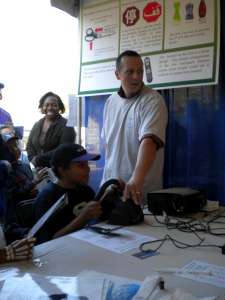 Even the youngest visitors to the FABBS Foundation’s booth at the USA Science and Engineering Festival Expo got a turn at the wheel.
Even the youngest visitors to the FABBS Foundation’s booth at the USA Science and Engineering Festival Expo got a turn at the wheel.
But when the kids were asked to send a text message while working a foot pedal and steering a car on a video screen, “they were colliding into walls and going off the road,” recalled Haneen Saqer, a graduate student at George Mason University who assisted in coordinating the event.
FABBS Foundation joined forces with the George Mason University’s Human Factors and Applied Cognition Program to organize the booth at the nation’s first-ever science and engineering festival, held October 23-24, 2010, in Washington, DC.
 Saqer and classmate Nicole Werner coordinated weekend coverage of the booth, “Where Science Meets the Mind”. Seventeen graduate students and two faculty also provided support for the two-day event.
Saqer and classmate Nicole Werner coordinated weekend coverage of the booth, “Where Science Meets the Mind”. Seventeen graduate students and two faculty also provided support for the two-day event.
“We know from research that most people don’t multitask well,” Werner said, explaining the booth’s “take-away” message. “When you drive while texting, both tasks suffer.”
Safe driving is just one aspect of human factors, the science of applying the ways people think to system designs. Whether the focus is on driving, using automated systems to send drones into space, or designing user-friendly tools or mobile technologies, the overall goal of the science is to improve systems so people’s lives are safer, easier and more enjoyable.
Using optical illusion to illustrate differences in perception and reality, the George Mason volunteers held up a white paper with three lines of equal length. Children gathered at the booth all guessed incorrectly that the last line was the longest. On another sheet–is it a B or a 13? Most children said 13, but Werner explained it could be either depending on whether the brain reads the A B C, which appears vertically or the 12 13 14, which appears horizontally.

On yet another sheet, RED is written in yellow, YELLOW is written in red and GREEN is written in blue. “It’s a basic psychological principle,” Saqer said. “You’re trying to focus on the color, but your brain automatically wants to read the words, causing errors and forcing you to go slowly.” Psychologists know this as the Stroop task.
The driving simulator was perhaps the biggest draw. “But once they were there, they were interested in the optical illusions,” Saqer said.
The organizers and volunteers were pleased not only with the weekend’s turnout but also with interest in the FABBS Foundation’s booth. At closing time on Sunday night, even elementary-school-aged visitors were still asking questions and asking to participate in the driving simulation.
Learn more about FABBS’ booth at the USA Science & Engineering Festival »
What happens when inexperienced drivers get behind the wheel?
While he has good control over the vehicle when he has both hands on the wheel, watch what happens when a teen attempts to send a text message and continue driving.